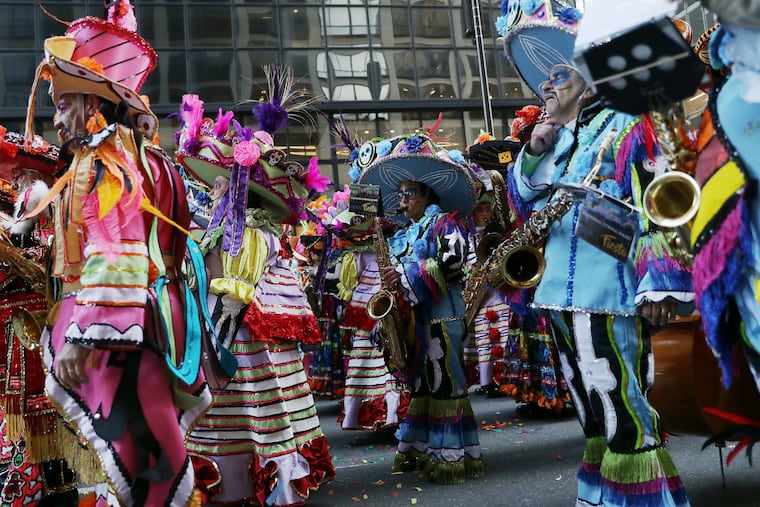The Mummers parade is redeemable | Opinion
The parade is behind the times in diversity, no question. But it's still Philadelphia’s biggest and best people’s parade.

Let’s start with some context on the latest eruption from Broad Street: There’s no “The” in the Mummers.
The New Year’s Parade is a loose coming-together of dozens of clubs and thousands of marchers in five separate divisions – almost like five separate parades back to back. This year’s parade had 16 string bands, 12 fancy brigades, 33 comic divisions, hundreds of individual and small group comics and fancies – and oh yes, nine wench brigades.
There’s never been a count of participants but based on my years covering the parade, I’d put it between 8,000 and 10,000 in costume, several thousand more as aides, and marshals with each of the above. No umbrella organization speaks for, much less polices, all Mummers.
Even the clubs within a division rarely have much to do with each other except for fierce bragging-rights competition. There are some loose associations with officers, but no central authority. Think of Mummers clubs, regardless of division or theme, as “silos," in the modern parlance.
As for Mr. Dumb and Mr. Dumber who smeared on blackface this year, jumped around in the mass of Mummers humanity known as Froggy Carr, and then bragged about it, the guys on Two Street already have a word for them: “knuckleheads.”
The knuckleheads need to be identified and weeded out. The leaders of each wench brigade are responsible for every dress-wearing participant, and they must – must – step up with a knucklehead-proof way to police their own. The very term “wench” itself seems due for some tough 21st-century scrutiny.
That said, there’s a cliché that is probably older than Mummery itself: Don’t throw out the baby with the bathwater.
» READ MORE: Two Mummers who wore blackface ‘are never going to be allowed to march again’ for Froggy Carr Wench Brigade
The Mummers Parade is a major part of the city’s self-image and its wider cultural fame. Not everyone, but throngs of people, love it — you know who you are. The string bands and fancy brigades are overwhelmingly year-round, hardworking folks who sustain themselves by renting out for parades, conventions, parties, and festivals. Clubs are self-sufficient, members shell out of pocket for supplies, and their costumes and materials are a significant investment. City prize money flew away years ago.
Many of the performers and clubs that Philadelphians, visitors and TV watchers love are in divisions that are already closely monitored by the city and by the clubs themselves. The city screens parade plans such as string band themes along with makeup and costume designs, puts spotters on the street, and recruits and coaches judges.
» READ MORE: Why this former Mummer has hung up his golden slippers | Jenice Armstrong
The bulk of city expense is in policing, cleanup, and spectator amenities such as stands, toilets, and barricades. The city provides these services for a calendar full of cultural and holiday parades. It has cut overtime and staffing costs in recent years by insisting on a shorter, tighter parade — if you can call seven hours short.
The parade is behind the times in diversity, no question. It has a rich history, a sordid-at-times history, and it comes undeniably from racist roots. But I believe it’s redeemable.
There are string bands constantly shopping for musicians who will put in the rehearsal time required. The Comic Division mother clubs are open to any group that wants to put together an entry. (A cheer here for those Chestnut Hill Mummers from the Venetian club, artisan coops like the Vaudevillains, and drummer and step-dance clubs that have joined the parade.)
It is Philadelphia’s biggest and best people’s parade, even with its flaws. Mostly, it ain’t broke – don’t kill it.
Ron Goldwyn covered Mummers and the parade for the Daily News for more than two decades and was a commentator on the parade telecast for 20 years.